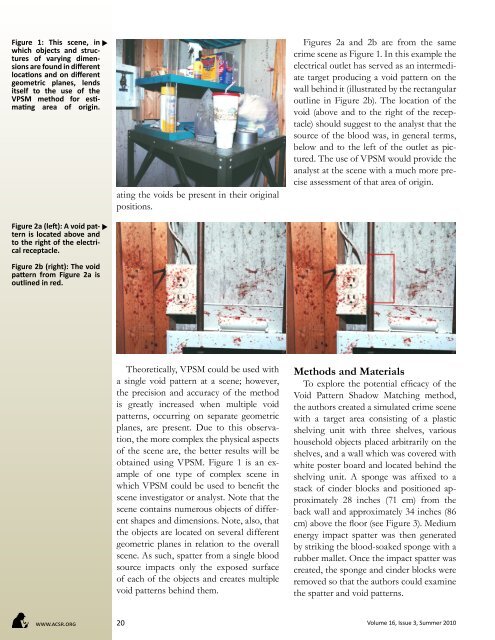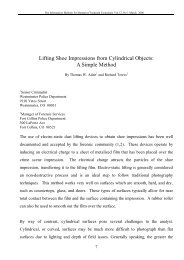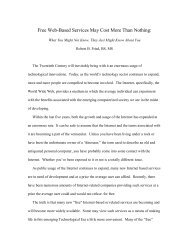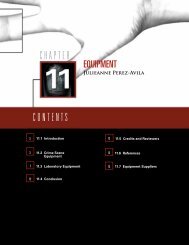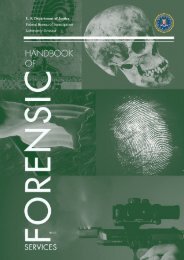Using Multiple Void Patterns at Crime Scenes to Estimate Area of ...
Using Multiple Void Patterns at Crime Scenes to Estimate Area of ...
Using Multiple Void Patterns at Crime Scenes to Estimate Area of ...
Create successful ePaper yourself
Turn your PDF publications into a flip-book with our unique Google optimized e-Paper software.
Figure 1: This scene, in<br />
which objects and structures<br />
<strong>of</strong> varying dimensions<br />
are found in different<br />
loc<strong>at</strong>ions and on different<br />
geometric planes, lends<br />
itself <strong>to</strong> the use <strong>of</strong> the<br />
VPSM method for estim<strong>at</strong>ing<br />
area <strong>of</strong> origin.<br />
Figure 2a (left): A void p<strong>at</strong>tern<br />
is loc<strong>at</strong>ed above and<br />
<strong>to</strong> the right <strong>of</strong> the electrical<br />
receptacle.<br />
Figure 2b (right): The void<br />
p<strong>at</strong>tern from Figure 2a is<br />
outlined in red.<br />
www.acsr.org<br />
<br />
<br />
<strong>at</strong>ing the voids be present in their original<br />
positions.<br />
Theoretically, VPSM could be used with<br />
a single void p<strong>at</strong>tern <strong>at</strong> a scene; however,<br />
the precision and accuracy <strong>of</strong> the method<br />
is gre<strong>at</strong>ly increased when multiple void<br />
p<strong>at</strong>terns, occurring on separ<strong>at</strong>e geometric<br />
planes, are present. Due <strong>to</strong> this observ<strong>at</strong>ion,<br />
the more complex the physical aspects<br />
<strong>of</strong> the scene are, the better results will be<br />
obtained using VPSM. Figure 1 is an example<br />
<strong>of</strong> one type <strong>of</strong> complex scene in<br />
which VPSM could be used <strong>to</strong> benefit the<br />
scene investig<strong>at</strong>or or analyst. Note th<strong>at</strong> the<br />
scene contains numerous objects <strong>of</strong> different<br />
shapes and dimensions. Note, also, th<strong>at</strong><br />
the objects are loc<strong>at</strong>ed on several different<br />
geometric planes in rel<strong>at</strong>ion <strong>to</strong> the overall<br />
scene. As such, sp<strong>at</strong>ter from a single blood<br />
source impacts only the exposed surface<br />
<strong>of</strong> each <strong>of</strong> the objects and cre<strong>at</strong>es multiple<br />
void p<strong>at</strong>terns behind them.<br />
20<br />
Figures 2a and 2b are from the same<br />
crime scene as Figure 1. In this example the<br />
electrical outlet has served as an intermedi<strong>at</strong>e<br />
target producing a void p<strong>at</strong>tern on the<br />
wall behind it (illustr<strong>at</strong>ed by the rectangular<br />
outline in Figure 2b). The loc<strong>at</strong>ion <strong>of</strong> the<br />
void (above and <strong>to</strong> the right <strong>of</strong> the receptacle)<br />
should suggest <strong>to</strong> the analyst th<strong>at</strong> the<br />
source <strong>of</strong> the blood was, in general terms,<br />
below and <strong>to</strong> the left <strong>of</strong> the outlet as pictured.<br />
The use <strong>of</strong> VPSM would provide the<br />
analyst <strong>at</strong> the scene with a much more precise<br />
assessment <strong>of</strong> th<strong>at</strong> area <strong>of</strong> origin.<br />
Methods and M<strong>at</strong>erials<br />
To explore the potential efficacy <strong>of</strong> the<br />
<strong>Void</strong> P<strong>at</strong>tern Shadow M<strong>at</strong>ching method,<br />
the authors cre<strong>at</strong>ed a simul<strong>at</strong>ed crime scene<br />
with a target area consisting <strong>of</strong> a plastic<br />
shelving unit with three shelves, various<br />
household objects placed arbitrarily on the<br />
shelves, and a wall which was covered with<br />
white poster board and loc<strong>at</strong>ed behind the<br />
shelving unit. A sponge was affixed <strong>to</strong> a<br />
stack <strong>of</strong> cinder blocks and positioned approxim<strong>at</strong>ely<br />
28 inches (71 cm) from the<br />
back wall and approxim<strong>at</strong>ely 34 inches (86<br />
cm) above the floor (see Figure 3). Medium<br />
energy impact sp<strong>at</strong>ter was then gener<strong>at</strong>ed<br />
by striking the blood-soaked sponge with a<br />
rubber mallet. Once the impact sp<strong>at</strong>ter was<br />
cre<strong>at</strong>ed, the sponge and cinder blocks were<br />
removed so th<strong>at</strong> the authors could examine<br />
the sp<strong>at</strong>ter and void p<strong>at</strong>terns.<br />
Volume 16, Issue 3, Summer 2010


